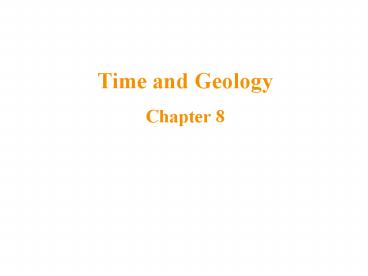Powerpoint Presentation Physical Geology, 10e - PowerPoint PPT Presentation
1 / 13
Title:
Powerpoint Presentation Physical Geology, 10e
Description:
... unconformities, and correlation of rock units and fossils ... by fossils ... appearance of complex life; many fossils. Geologic Time Scale. Mesozoic era ... – PowerPoint PPT presentation
Number of Views:149
Avg rating:3.0/5.0
Title: Powerpoint Presentation Physical Geology, 10e
1
Time and GeologyChapter 8
2
The Age of the Earth
Prior to the 19th century, generally accepted age
of the Earth was based on religious beliefs
6,000 years for Western culture (Biblical)
Old beyond comprehension (Chinese/Hindu)
James Hutton, thefather of geology, realized
observable geologic processes would require vast
amounts of time to produce the mountains,
valleys, etc., we see on Earth today
Charles Lyell popularized Huttons work and
concepts in his book, Principles of Geology
Uniformitarianism/actualism same processes and
natural laws that operated in the past are
operating at present - The present is the key to
the past
3
Relative vs. Numerical Age
Relative age - the order of events or objects,
from first (oldest) to last (youngest)
Determined by applying simple principles,
including original horizontality, superposition,
lateral continuity, cross-cutting relationships,
inclusions, unconformities, and correlation of
rock units and fossils Numerical age - the age of
events or objects, expressed as a number or
numbers Determined using radiometric dating (dete
rmining how much radioactive decay of a specific
element has occurred since a rock unit formed or
an event occurred
4
Relative Age Determination
Contacts - surfaces separating successive rock
layers (beds) Formation - body of rock of conside
rable thickness with recognizable characteristics
allowing it to be distinguished from adjacent
rock layers Original horizontality - beds of sedi
ment deposited in water formed as horizontal or
nearly horizontal layers
5
Relative Age Determination
Superposition - within an undisturbed sequence of
sedimentary or volcanic rocks, layers get younger
from bottom to top Lateral continuity - original
horizontal layer extends laterally until it
tapers or thins at its edges
6
Relative Age Determination
Cross-cutting relationships - a disrupted pattern
is older than the cause of the disruption
Intrusions and faults are younger than the rocks
they cut through Baked contacts - contacts betwee
n igneous intrusions and surrounding rocks, where
surrounding rocks have been contact
metamorphosed Inclusions - fragments included in
a host rock are older than the host rock
7
Unconformities
Unconformity - a surface (or contact) that
represents a gap in the geologic record
Disconformity - an unconformity in which the
contact representing missing rock layers
separates beds that are parallel to each other
Angular unconformity - an unconformity in which
the contact separates overlying younger layers
from eroded tilted or folder layers
8
Unconformities
Nonconformity - an unconformity in which an
erosion surface on plutonic or metamorphic rock
has been covered by younger sedimentary or
volcanic rock Plutonic and metamorphic rocks expo
sed by large amounts of erosion
Typically represents a large gap in the geologic
record
9
Correlation
Correlation - determining the time-equivalency of
rock units Within a region, a continent, between
continents Physical continuity Physically tracin
g a continuous exposure of a rock unit Easily
done in Grand Canyon Similarity of rock types As
sumes similar sequences of rocks formed at same
time Can be inaccurate if very common rock types
are involved Correlation by fossils Fossil speci
es succeed one another through the layers in a
predictable order (faunal succession)
Similar fossil assemblages (groups of different
fossil species) used
10
Geologic Time Scale
Standard geologic time scale Worldwide relative
time scale Subdivides geologic time based on foss
il assemblages Divided into eons, eras, periods,
and epochs Precambrian - vast amount of time prio
r to the Paleozoic era few fossils preserved
Paleozoic era - old life appearance of comple
x life many fossils
11
Geologic Time Scale
Mesozoic era - "middle life" Dinosaurs abundant o
n land Period ended by mass extinction Cenozoic
era - "new life" Mammals and birds abundant We a
re currently in the Recent (Holocene) Epoch of
the Quaternary Period of the Cenozoic Era
Most recent ice ages occurred during the
Pleistocene Epoch of the Quaternary Period
12
Numerical Age Dating
Numerical dating - puts absolute values (e.g.,
millions of years) on the ages of rocks and
geologic time periods Uses radioactive decay of u
nstable isotopes Only possible since radioactivit
y was discovered in 1896 Radioactive isotopes dec
ay in predictable manner, giving a characteristic
half-life (time it takes for a given amount of
radioactive isotope to be reduced by half)
13
Age of the Earth
Numerical dating gives absolute age for Earth of
about 4.55 billion years Oldest age obtained for
meteorites, believed to have been unchanged since
the formation of the solar system
Earth and rest of solar system very likely formed
at this time Geologic (deep) time is vast A long
human lifetime (100 years) represents only about
0.000002 of geologic time






























